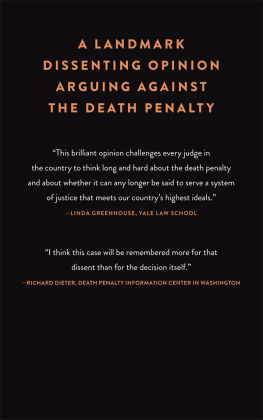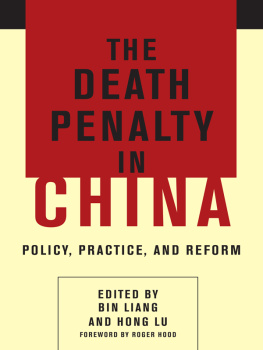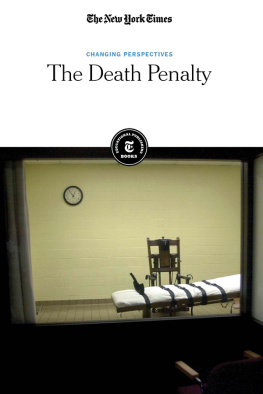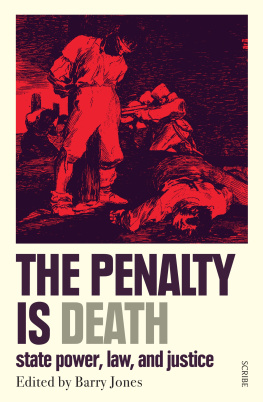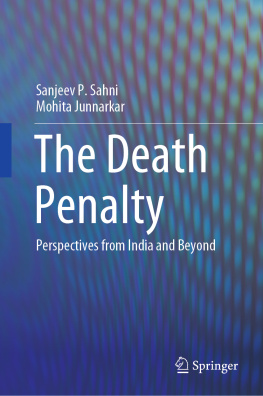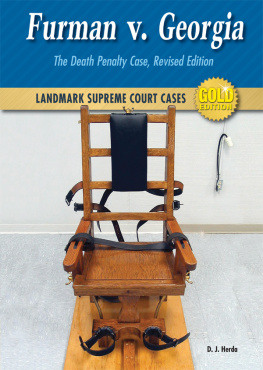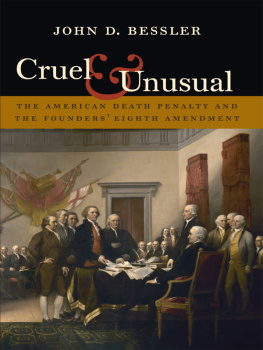AGAINST THE DEATH PENALTY
J USTICE S TEPHEN B REYER
Edited by John Bessler
BROOKINGS INSTITUTION PRESS
Washington, D.C.
Copyright 2016
THE BROOKINGS INSTITUTION
1775 Massachusetts Avenue, N.W., Washington, D.C. 20036
www.brookings.edu
All rights reserved. No part of this publication may be reproduced or transmitted in any form or by any means without permission in writing from the Brookings Institution Press.
The Brookings Institution is a private nonprofit organization devoted to research, education, and publication on important issues of domestic and foreign policy. Its principal purpose is to bring the highest quality independent research and analysis to bear on current and emerging policy problems. Interpretations or conclusions in Brookings publications should be understood to be solely those of the authors.
This book reprints Justice Stephen Breyers dissent in Glossip v. Gross, 135 S. Ct. 2726 (2015), text taken from the public record. Justice Breyer does not receive any compensation or remuneration for this book. The Brookings Institution, which has been publishing Stephen Breyers work since the 1970s (Stephen G. Breyer and Paul W. MacAvoy, Energy Regulation by the Federal Power Commission, 1974; Stephen Breyer, Economic Reasoning and Judicial Review, 2004), thanks The Atlantic for granting permission to reprint material contained in the appendices of Glossip v. Gross.
Library of Congress Cataloging-in-Publication Data
Names: Breyer, Stephen G., 1938 author. | Bessler, John D., editor, writer of introduction.
Title: Against the death penalty / Justice Stephen Breyer ; edited by John Bessler.
Description: Washington : Brookings Institution Press, 2016.
Identifiers: LCCN 2016017499 (print) | LCCN 2016017695 (ebook) | ISBN 9780815728894 (hardback) | ISBN 9780815728900 (ebook)
Subjects: LCSH: Capital punishmentUnited States. | BISAC: POLITICAL SCIENCE / Government / Judicial Branch. | POLITICAL SCIENCE / Constitutions. | POLITICAL SCIENCE / Political Freedom & Security / Human Rights. | POLITICAL SCIENCE / Political Process / General.
Classification: LCC KF9227.C2 B74 2016 (print) | LCC KF9227.C2 (ebook) | DDC 345.73/0773dc23
LC record available at https://lccn.loc.gov/2016017499
9 8 7 6 5 4 3 2 1
Typeset in Sabon
Composition by Westchester Publishing Services
CONTENTS
John Bessler
INTRODUCTION
John Bessler
AT THE NATIONS HIGHEST COURT
On April 29, 2015, the Supreme Court of the United States heard oral arguments in Glossip v. Gross .
In 2001, the Oklahoma Court of Criminal Appeals had granted Glossip a new trial because of his attorneys ineffective assistance of counsel. That court stated, Trial counsels failure to utilize important impeachment evidence against Justin Sneed stands out as the most glaring deficiency in counsels performance. Despite the existence of a videotaped confession of Justin Sneed that could have been used to impeach him and the detectives who interviewed him, defense counsel failed to make use of that videotape. The State concedes the only direct evidence connecting Appellant to the murder was Sneeds trial testimony, the court declared, pointing out that no compelling evidence corroborated Sneeds testimony that Appellant was the mastermind behind the murder. But in spite of that fact, Glossip was retried in 2004, and a new juryagain finding a murder-for-hire schemeconvicted him once more of capital murder. Before being killed, Van Treese had discovered a $6,101.92 shortfall in the motels books, and he had planned to confront Glossip about the motels finances and filthy condition. The motel was in a truly deplorable state, with only half of its rooms even habitable.
As a prosecution witness, Sneed had testified that at around 3:00 a.m. on January 7, 1997, a nervous and jittery Glossip had come to his room and promised him $10,000 to kill Van Treese.
The Oklahoma Court of Criminal Appeals ultimately affirmed Glossips conviction and death sentence. It found substantial evidence to support the jurys verdict, including alleged efforts by Glossip to conceal Van Treeses body after the murder. A window in Room 102 of the motel had been broken during Van Treeses struggle with Sneed, and there was also evidence that money had been taken from Van Treese after his murder. In its recitation of the case, the Oklahoma Court of Criminal Appeals reported that, according to Sneed, Glossip took a $100 bill from Van Treeses wallet; Glossip then told Sneed to drive Van Treeses car to a nearby parking lot and that he would find money in an envelope under the seat; and Sneedwho retrieved
The April 2015 oral argument before the U.S. Supreme Court arose out of a lawsuit filed by Richard Glossip and other Oklahoma death row inmates. The suit alleged that the states method of executionlethal injectionviolated the U.S. Constitutions Eighth Amendment because it created an unacceptable risk of severe pain. The case was originally captioned Warner v. Gross ,
As the U.S. Supreme Court considered Glossip v. Gross , a repetition of what happened at Clayton Locketts execution was certainly not out of the question for future Oklahoma executions. The lethal injection protocol that had been used at Locketts bungled execution was, in fact, very similar to the one planned for Richard Glossip. At Locketts execution, the three-drug protocol consisted of 100 milligrams of midazolam, a substance to induce unconsciousness; vecuronium bromide, to cause paralysis; and potassium chloride, to stop the heart. Locketts autopsy showed that a sufficient quantity of midazolam was present in his system to render an average person unconscious, but he moved and spoke during his final moments of life. An Oklahoma report issued in the aftermath of Locketts botched execution laid blame for what happened on the execution teams failure to properly insert the intravenous line. Instead of entering Locketts bloodstream, a large quantity of the drugs had pooled in the tissue near the IV access point and stayed there. The three-drug protocol to be used at Glossips execution, by contrast, was to consist of 500 milligrams of midazolam;
The four dissenters in Warner v. Gross had ample and legitimate reasons to fear what might happen at Oklahoma executions in light of the states track record and midazolams pharmacological properties. The dissenters pointed out that the U.S. Food and Drug Administration had not approved midazolam for use as an anesthetic because an individual could likely regain consciousness if exposed to noxious stimulisuch as the injection of potassium chloride. Indeed, at a three-day evidentiary hearing, Dr. David Lubarsky, an anesthesiologist, had explained that midazolam is subject to a ceiling effect, such that, no matter how high the dosage, it eventually reaches a saturation point in the body and might not keep someone unconscious. That feature distinguished midazolama benzodiazepine, like Valium or Xanaxfrom sodium thiopental or pentobarbital, barbiturates that American states had previously used at executions as the first drug in three-drug protocols.
By the time of Charles Warners execution, the once readily available lethal injection drugssodium thiopental and pentobarbitalwere no longer available for use at Oklahoma
The U.S. Supreme Courts failure to halt Charles Warners execution was especially remarkable because four justicesthe number needed for the Court to grant review of a casewanted to consider Warners claims but fell just one vote shy of the five votes needed to grant a stay of execution.
At the April 2015 oral argument in Glossip v. Gross , Robin Konradcounsel for Richard Glossip and Oklahomas other death row inmates, now minus Charles Warnerwas peppered with questions about the states lethal injection protocol. At one point, Associate Justice Samuel Alito interjected, Now, this Court has held that the death penalty is constitutional. Its controversial as a constitutional matter. It certainly is controversial as a policy matter. In the lead up to his question, he pressed further, Those who oppose the death penalty are free to try to persuade legislatures to abolish the death penalty. Some of those efforts have been successful. Theyre free to ask this Court to overrule the death penalty. But until that occurs, he added, posing his question, is it appropriate for the judiciary to countenance what amounts to a guerilla war against the death penalty which consists of efforts to make it impossible for the States to obtain drugs that could be used to carry out capital punishment with little, if any, pain?
Next page
